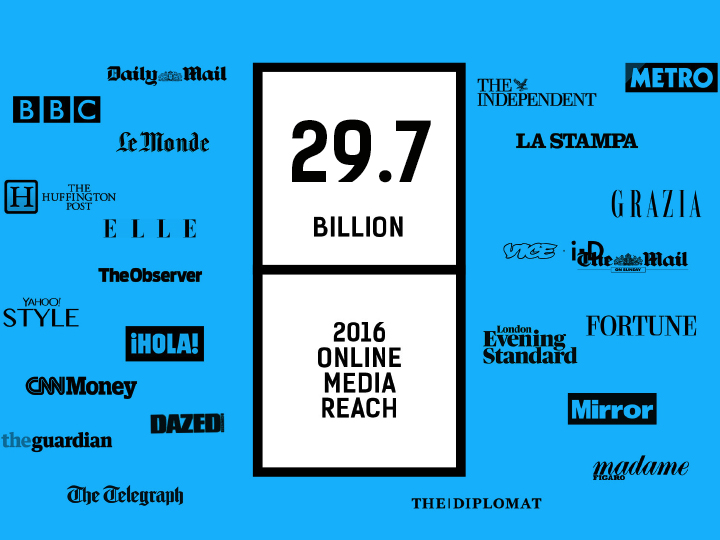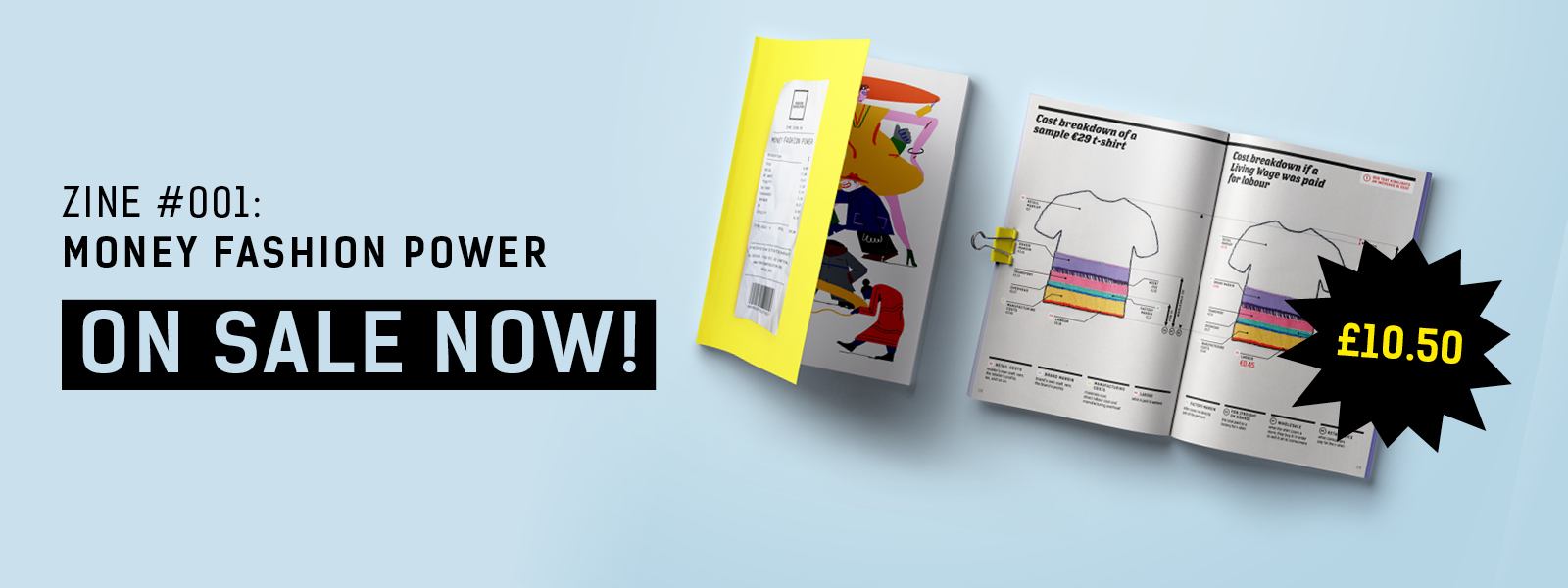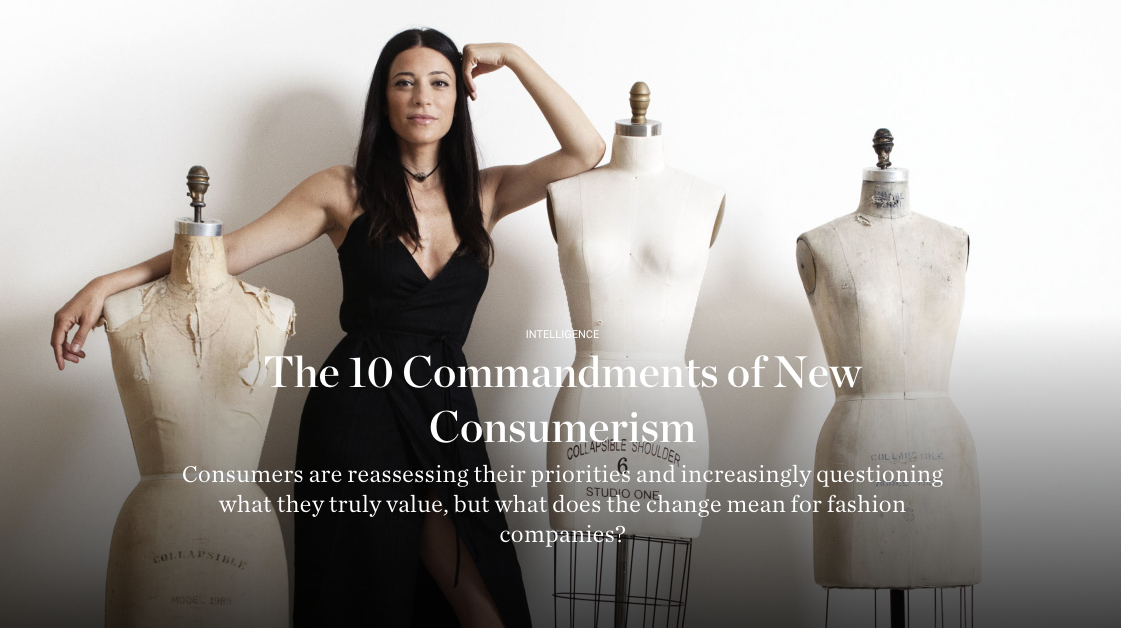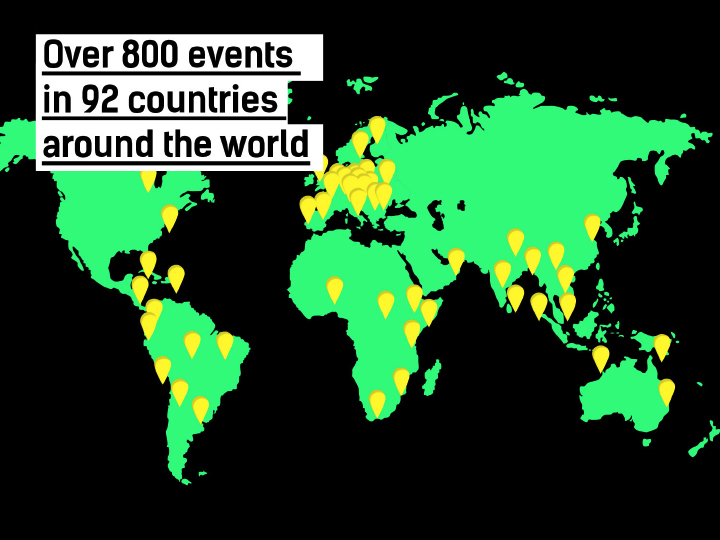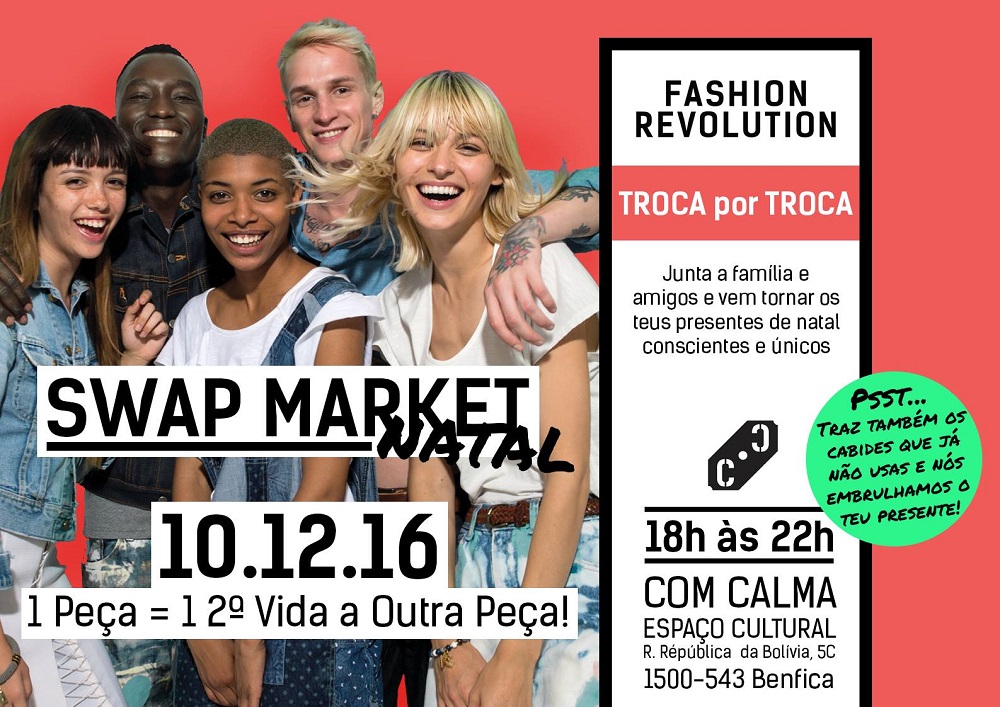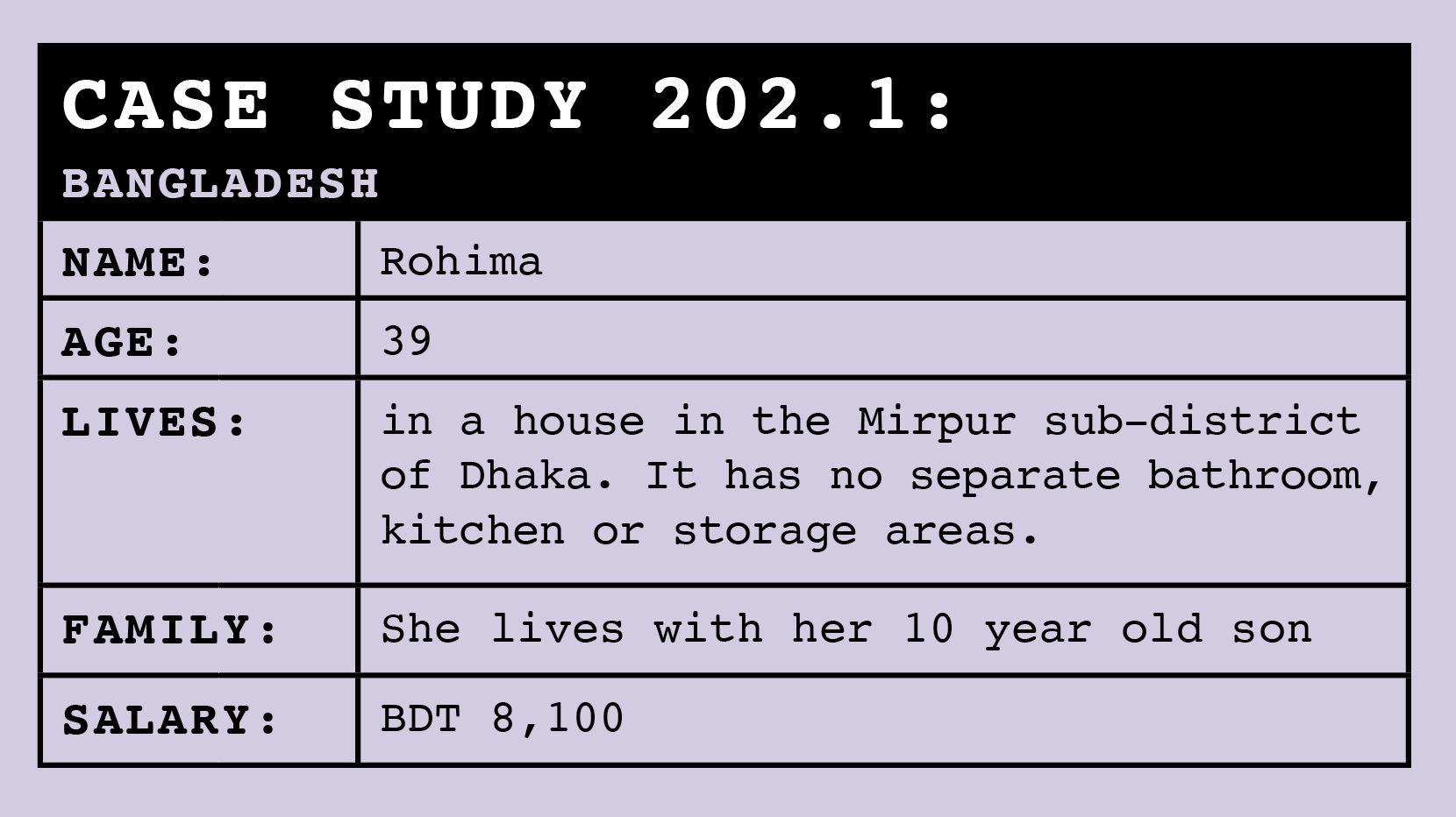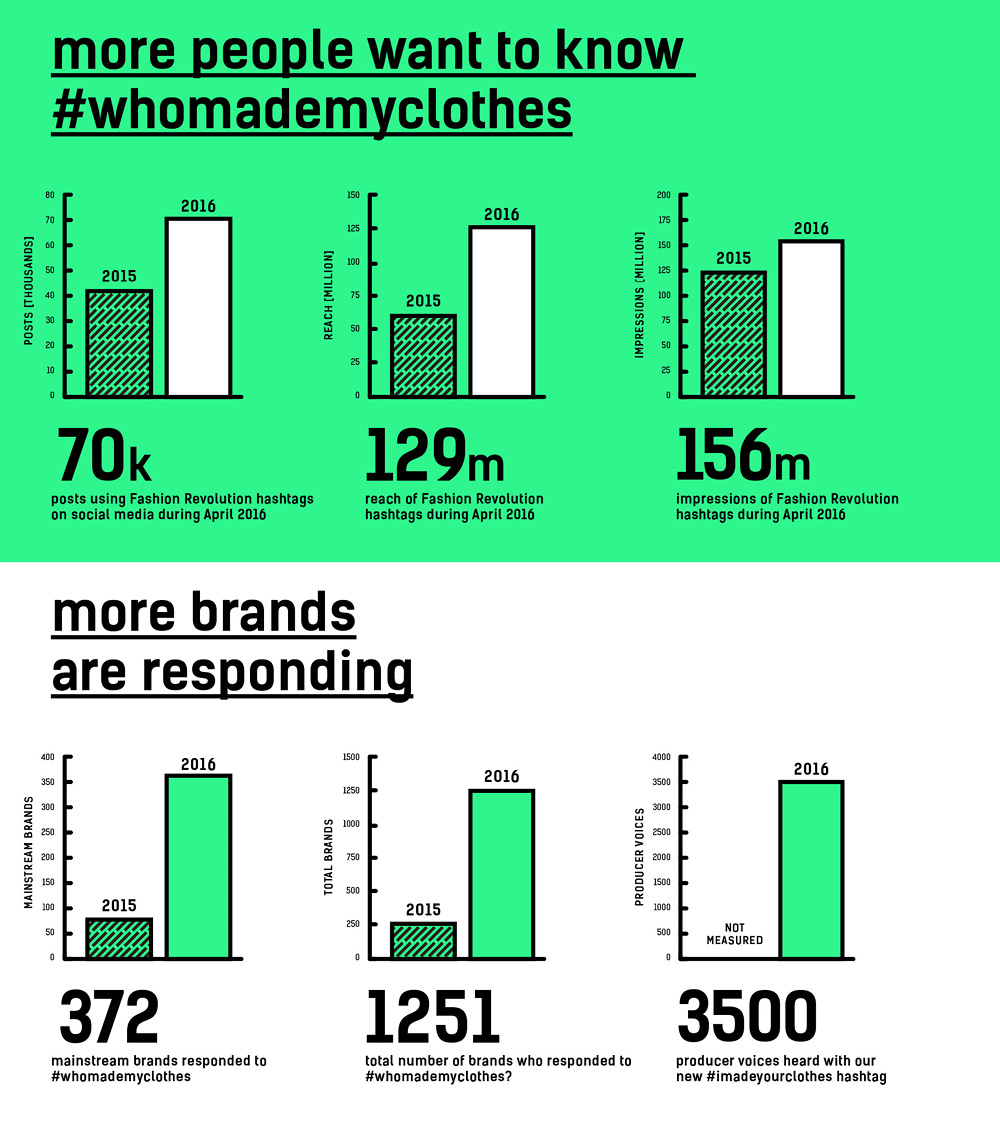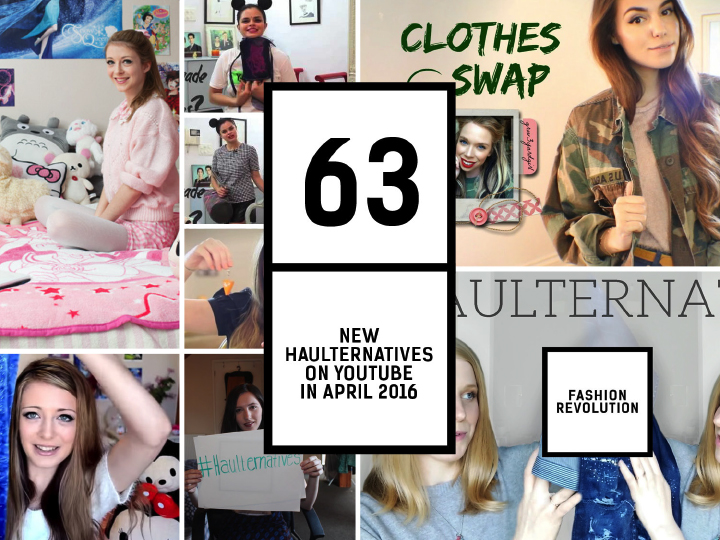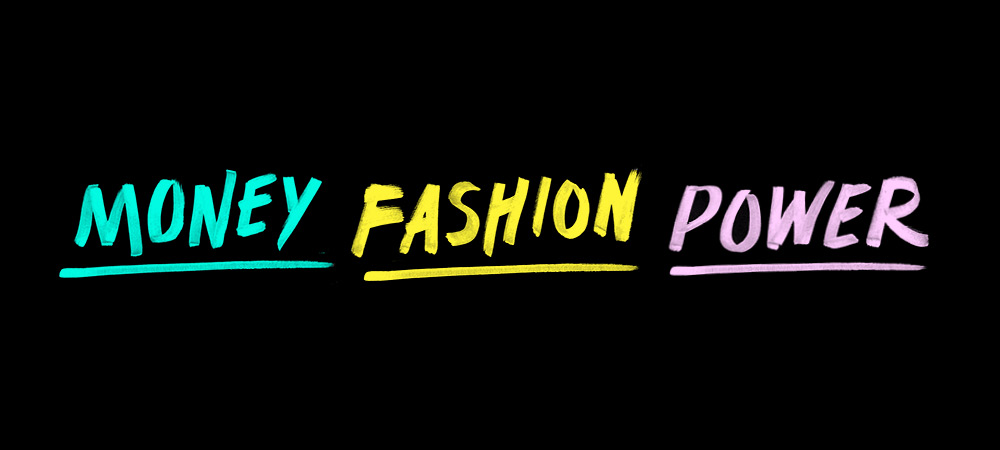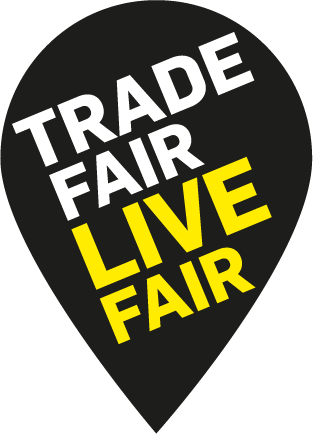On the 12th Day of Christmas
12 months of press coverage.
1619 press articles generating Circulation (Potential Viewership) of 29.7 billion, according to Meltwater press figures.
On the 11th Day of Christmas
11 steps to creating a revolution.
Blueprint for Revolution by Srdja Popovic is one of the books and reports reviewed in Fashion Revolution fanzine #001 Money Fashion Power. Through 72-pages of poetry, illustration, photography, graphic design and editorial, this collectible zine explores the hidden stories behind your clothing, what the price you pay for fashion means, and how your purchasing power can make a positive difference. Published in January and available for pre-order now.
On the 10th Day of Christmas
Business of Fashion published the 10 Commandments of New Consumerism
BoF outlined the 10 factors that define new consumerism and what this change in shopping habits could mean for fashion brands and retailers. BoF said “For decades, a brand’s only priority was to create the best possible product at the most competitive price to ensure sales. But as consumers develop a more comprehensive understanding of issues like sustainability, authenticity and transparency, brands and retailers are being forced to change the way they sell in order to survive”. Coming in at no. 1 in the 10 Commandments for New Consumerism is: Provide Transparency Into Your Business Practices.
On the 9th Day of Christmas
92 countries around the world were involved in Fashion Revolution Week in April 2016.
And even more countries have joined the movement since April. Find out what’s happening in your country.
On the 8th Day of Christmas
Over 800 Fashion Revolution events around the world.
Clothes swaps, film screenings, exhibitions, fashion shows, panel discussions, selfie walls, Fashion Question Time in the UK Houses of Parliament and more. Find out what’s happening in your country on our Events page.
On the 7th Day of Christmas
7th most successful global PR campaign in The Global SABRE awards.
The Global SABRE awards honour the world’s 40 top public relations programs of the past year. Ketchum came 7th for the Fashion Revolution Germany video, €2 T-Shirt – a Social Experiment which has received over 7.6 million views to date.
On the 6th Day of Christmas
6.30am Wake Up, 1.30am Sleep.
Garment Worker Diaries, lead by Microfinance Opportunities and funded by C&A Foundation, is gathering firsthand accounts of 540 garment workers in Bangladesh, Cambodia and India. Researchers are collecting information on what these women earn, spend, put in and take out of their savings, borrow from others, and lend to others. We are also learning about their daily schedules and what kind of conditions they’re working in at the factory. Over the course of 12 months we will have a better understanding how these garment workers survive on low pay and deal with problems such as chronic pain, harassment or illness. Find out more the daily routine of a garment worker, how much she earns and how much she spends in a week in our Money, Fashion, Power fanzine.
On the 5th Day of Christmas
5 out of the 40 brands on our inaugural Fashion Transparency Index were publishing their factory lists.
However, since April we have seen Gap, Marks and Spencer, VF Corporation (who owns The North Face, Vans, Wrangler and others) and Jeanswest publish a list of the factories where their clothes are stitched and Inditex, who own Zara, Massimo Dutti and Pull and Bear among other brands, has published a list of the facilities where its clothing is dyed, washed, printed and where leather is tanned.
The 2017 Fashion Transparency Index will cover 100 of the world’s largest fashion brands.
4 campaign hashtags used during 2016
#FashRev (general), #whomademyclothes (ask to brands) #imadeyourclothes (producer photos and stories) and #haulternative (alternative ‘hauls’) generating 156 million impressions during Fashion Revolution Week.
For 2017 our hashtags will be #FashionRevolution, #whomademyclothes, #imadeyourclothes and #haulternative.
On the 3rd Day of Christmas
3.11 million views of Fashion Revolution videos in 2016.
Fashion Revolution Brasil’s Fashion Experience: o outro lado da moda, Fashion Revolution Germany’s The Child Labour Experiment, #Haulternatives by Cutie Pie Marzia and Maddu, plus over 60 more #Haulternative and Love Story videos posted by people around the world.
Find out how to make your own #Haulternative and Love Story videos on our website.
On the 2nd Day of Christmas
2 founders of Fashion Revolution, Carry Somers and Orsola de Castro were named amongst the most influential people in London 2016.
Carry Somers and Orsola de Castro were listed in the Evening Standard’s Progress 1000 Awards in the Equality Champions category which included the Duke and Duchess of Cambridge, the Duchess of Cornwall, David Beckham, Richard Gere and Stephen Fry,
On the 1st Day of Christmas
One global campaign changing the fashion industry.
Please be a part of the Fashion Revolution and help to make our voice even louder in 2017. Be Curious. Find Out. Do Something About It.
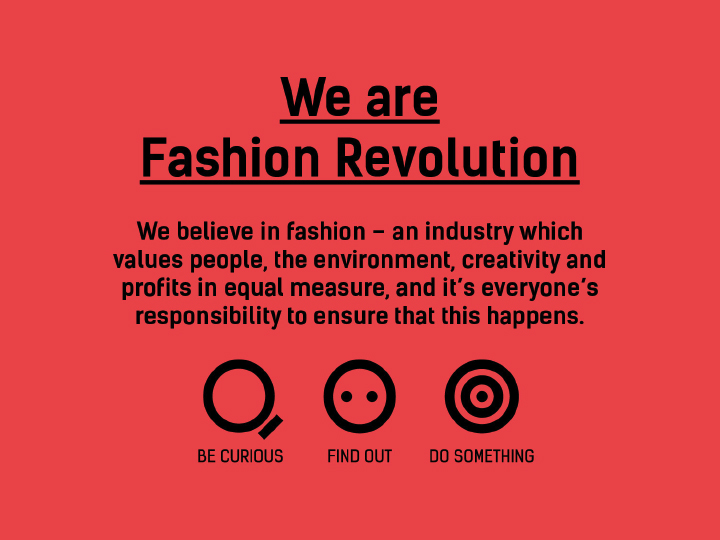
Help us launch our 2017 theme MONEY, FASHION, POWER.
Please donate to keep strengthening the movement.
There is a before and after Rana Plaza. We have all heard stories about sweatshops and yet we in the developed world are so far removed from them, it is hard for us to grasp the impact of working in these facilities. The news about the collapse of a building across the world where almost 1,200 people died is treated as news just like an earthquake or a tsunami. But unlike natural disasters, these catastrophes are man made. They happen because of greed, desperation, a lack of moral compass and a willingness to ignore others and their well-being.
Although Zara was not involved in this atrocity, they are synonymous with fast fashion. Armancio Ortega, inspired by newfound freedoms of democracy in 1974, created an affordable apparel label for the frugal Spaniard of the region of Galicia. When Ortega created Zara, the poor region of Galicia thrived with his success. The production was local and employed co-ops and other local sewing companies. Over time, his strategy to offer very affordable fashion using the latest trends on an almost zero in-store inventory model paid off, but forced him to move production to under-developed countries. These business decisions made sense when only looking at the bottom line, however moving production abroad helped create a vacuum of oversight and accountability with their subcontractors.
Now, a couple decades later, the fast fashion industry is facing a backlash. Rana Plaza was hardly the first time that fast-fashion brands such as The Gap or Zara made headlines for their sweatshops, but it feels as though the world is finally ready for a change. For the first time, there could be real financial consequences for fast-fashion companies. People are now craving something different: quality, accountability and connection. People care more about the story behind the products they buy and are more educated about them than ever before.
However, we cannot wait for the big players of the fashion industry to change on their own. We are responsible for creating the change we want to see in mass-market fashion labels. This is why campaigns like “Who Made My Clothes?” are so important. If consumers are more aware of how and who makes their clothes, they will make more educated choices.
But change is coming, in a pure battle of David against Goliath. This is evidenced in the rise of the fashion social enterprises. Vavavida, Zady, Prana, Toms shoes, Warby Parker glasses, and a slew of others all stemmed from fashion entrepreneurs wanting to shake up the industry. These companies are seeking a true connection between what they make, how they are made and how customers experience their products.

Fair Trade will help usher in a new standard of how we treat the people we do business with and change the relationship we have with the products we buy. Being ethical starts at the very base of this new business model. In the best of cases, Fair Trade can be (and should be) the lowest echelon on the ethical production ladder of how to create, sell and market ethical fashion.
But is fair trade enough?
Fair Trade is not the answer to every problem, but it can be part of the solution. Fair Trade is only the beginning and yet we are a long way from making fair trade a standard in every household in America. The awareness of Fair Trade and what it means is still very low. Apart from coffee and chocolate connoisseurs, fair trade is virtually unknown in the US market. We need to raise awareness so that things can start changing for the better.
Full Circle Economics©
This is why when we created Vavavida we wanted to start with Fair Trade as a first step in the right direction and then close the loop. We created what became our operating model of Full Circle Economics©. We source our products from disadvantaged artisan cooperatives from around the world that adhere to the Fair Trade principles, we sell the items at a fair price and —thanks to our non-profit partner Project Concern International— we then use part of the revenues earned from the sales of those goods to re-invest into the communities we source our products from. Since our products are almost entirely made for women and by women, we chose to close the loop by investing in female economic empowerment programs that exist as close as possible to the co-ops we buy from.

From what we know at Vavavida of the effects of Fair Trade on the communities we partner with, it is evident that Fair Trade works. The main co-operative we source our products from has seen its wages rise by 800% ever since they started operating under the Fair Trade principles. The community has also seen a reduction of the impact their work has on the environment and because of Fair Trade, their kids remain in school much longer. But we need to do more. Women are the most affected by poverty but are also the likeliest to pull a community together out of poverty. Therefore, we need to invest in programs that focus on children’s education, female empowerment and women-led village savings program to help a community pull itself out of poverty and create a more sustainable local economy. Fashion done right can save the world.
All content on our blog is editorially independent unless it has been written by a member of the Fashion Revolution team.
Thanks Zara. Bold title for an ethical and sustainable blog? Perhaps a little, I know, but this “thanks” to Zara is completely justified and I believe completely deserved. Want to know why?
A few weeks ago I took up the challenge launched by Fashion Revolution and the Asociación Moda Sostenible for Fashion Revolution Day encouraging us to ask the brands ‘Who Made My Clothes?’, with the aim to make us reflect about how the clothing we wear is made and to make the brands realise that, even if their garments are produced in workshops subcontracted by other companies, they have a huge responsibility to know who made them and, above all, under what working conditions.
Okay, so for my challenge I asked the Spanish brand Zara who had made my hoodie.
The truth is that when I recorded the video I did not expect that Zara, flagship of the Inditex group, would answer. Who was I that this kind of multinational brand would pay attention to my question?
Well I was completely mistaken, because just a few days after tweeting the question to the brand, I started to get messages from Zara Care (Twitter account for Zara’s customer services) informing me of the process of my query until, on the 14th April, the brand replied to my question via Facebook. I’ve pasted the messages below.
Zara Facebook message:
Hello, the item from your video is a hooded jacket sold by Zara in 2009. This garment came from a Turkish business (Uniteks Gida Tekstil) who carried out the production in two factories: BGB Tekstil and Tekova Tekstil. Both factories are located in Izmir (western Turkey); the first has around 140 workers and the second about 100. Uniteks, just like BGB and Tekova, continue to form part of Inditex’s current supply base. Their workshops have surpassed the most recent full social audit in January 2014 and in July 2013 respectively (audits of those manufacturers that obtain high ratings are carried out every 24 months), and subsequent to these dates they have received visits from technical assistance (related to implementation of improvements) as well as regular production controls (necessary to ensure complete traceability of our products).
We hope that this information is useful to you.
So my hoodie had been made by two Turkish businesses subcontracted by a third one that Zara had originally subcontracted? “That’s a lot of contracts!” was my first thought. No wonder they took 15 days to be able to reply… Still, I suppose that, whether we like it or not, in multinational businesses it’s like this every day. In the end, big businesses also subcontract me to help them develop part of their communication strategies and Corporate Social Responsibility.
The second thing that surprised me was Zara’s ability to let me know the traceability of their garment manufacturing. I understand that it has to be like that, but that didn’t stop it being a pleasant surprise. As you can see in the messages, to find out exactly they asked me for the model of the jacket. If I’m not mistaken it was Uniteks Gida Tekstil who subcontracted both BGB Tekstil and Tekova Tekstil.
The third part that caught my attention was that six years later the three companies are still working for the group and that they had social audits in 2013 and 2014 carried out by Zara. But, what exactly does this “social audit” mean?
According to Zara’s webpage:
The production facilities of all suppliers whithin Inditex’s supply chain are audited periodically by Inditex’s CSR teams or specialist external auditors in order to assess their level of compliance with the Code of Conduct for Manufacturers and Suppliers. These audits have been developed in accordance with Inditex’s Tested to Wear methodology, designed in 2007 in collaboration withIndustriALL (formerly ITGLWF), the Cambridge Centre for Business and Public Sector Ethics and Inditex. The methodology is reviewed periodically to incorporate appropriate updates and factor in the experience gained. The last review took place in 2013.
Once a supplier has signed Inditex’s Minimum Requirements, its facilities and any other factories and workshops it works with undergo an initial CSR audit.
These audits consist of facility inspection, documentary due diligence (management systems, payrolls, work hour ledgers, production records, employee documentation, permits, etc.), verification of waste management, emissions and water and energy usage, and interviews with factory managers, employees, union representatives and health and safety staff, among things.
For the duration of its business relationship with Inditex, the suppliers and their associated facilities undergo periodic audits.
I know audits can’t guarantee that the workers’ social and labour rights are respected in these subcontracted factories, given that it’s really difficult to gauge the actual reality of a company from one of these inspections (all of us have experienced one of these audits at work and surely no one – at least I haven’t ever – has actually been privately questioned by the auditor to find out exactly how the company treats them. And if it does happen, that that brave person has been able to criticise their bosses without fearing reprisal…). Still, this is the system that exists and we have to trust it. Here you can see the conditions that Inditex requires from their providers.
Not just settling for Zara’s reply, I took the opportunity to find out some more information about the businesses mentioned on the Clean Clothes Campaign (international campaign which focuses on the working conditions of garment workers), but I haven’t been able to find any reference to these three Turkish companies. If anyone from the CCC reads this and has any more info, please get in touch! I did, however, find the analysis of Zara that ‘Ropa Limpia’ (Clean Clothes in Spain) did in 2010.
Whatever the case may be, I hope that after reading my post you understand this ‘Thanks Zara’ in the title. And, as far as I know, of all the videos from the #retomodasostenible that have been recorded for Fashion Revolution Day in Spain, only this one and María Pérez-Hickman’s, who asked Esesoese, have received a response. Have a look at #retomodasostenible on facebook y #retomodasostenible on Twitter. Check #whomademyclothes to see global questions and responses.
Thanks again to Zara for paying attention to this challenge and, in this way, stepping up to Fashion Revolution Day.
From here, I encourage the brand and also the whole of the Inditex group to continue working so that all of us fashion lovers can feel proud to wear their clothing now that we’re adults and have more awareness, with the same emphasis that we used to when we were teenagers.
For my generation, Zara allowed us to be the first ‘fashion’ kids and teenagers in history; they gave us the opportunity to be fashionable at an affordable price; they made us believe that through hard work a small business could conquer the whole world. Now that we’re adults – and I think I speak for my whole generation – we would love Zara to prove that this hasn’t been achieved at the cost of other people’s health and quality of life. And if, out of ignorance, or greed or a lack of awareness, at any point in the business’ history this has been the case, I would be satisfied knowing that this is already a thing of the past and that from now onwards no one will ever see their human and workers’ rights violated so that a t-shirt might cost me a few euros less or so that the company selling it might earn a few euros more. Deal? Given Zara’s response to my question, I think it’s a deal.
Thanks in advance, Zara.
Thanks to Kezia Cochrane https://thefiveanddime.wordpress.com/ for the translation
Hace unas semanas me sumaba al reto que Fashion Revolution y la Asociación Moda Sostenible han lanzado con motivo del Fashion Revolution Day (aquí te contaba de qué va este evento) animándonos a preguntar a las marcas “¿Quién hizo mi ropa?”, con el objetivo de hacernos reflexionar sobre cómo se produce la ropa que vestimos y hacer caer en la cuenta a la marcas de que, aunque sus prendas sean producidas en talleres de empresas a las que subcontratan, tienen una gran responsabilidad de saber quién las hizo y, sobre todo, bajo que condiciones laborales.
Pues bien, en mi reto yo pregunté a la marca española Zara quién había producido mi sudadera con cremallera.
La verdad es que cuando grabé el video (te lo he vuelto a incrustar aquí arriba por si no lo habías visto) no tenía ninguna esperanza de que Zara, el buque insignia del grupo Inditex, me contestara. ¿Quién era yo para que una multinacional de estas características prestara atención a mi pregunta?
Pues estaba muy equivocada, ya que a los pocos días de lanzar la pregunta en el Twitter de la marca, empecé a recibir mensajes de Zara Care (el Twitter del servicio de atención al cliente de Zara) informándome del proceso de mi consulta hasta que, el pasado 14 de abril, la marca respondió a mi pregunta vía Facebook. Os copio a continuación la cadena de mensajes.
¿Así que mi chaqueta con capucha había sido producida por dos empresas turcas subcontratadas por una tercera que es la que realmente había subcontratado Zara? “¡Madre mía cuántos contratos!”, fue lo primero que me vino a la mente. No me extraña que tardaran 15 días en poder responder… Aún así, supongo que, nos guste o no, en empresas multinacionales el día a día es así. Al fin y al cabo, a mí también me subcontratan grandes empresas para ayudarles a desarrollar parte de sus estrategias de comunicación y de Responsabilidad Social Corporativa.
Lo segundo que me sorprendió fue la capacidad que tuvo Zara para informarme de la trazabilidad de las producción de la prenda. Entiendo que tiene que ser así, pero eso no quita que me haya sorprendido gratamente. Como ves en la cadena de mensajes, para saberlo con exactitud me pidieron la referencia de la chaqueta. Si no he entendido mal fue Uniteks Gida Tekstil que a la vez subcontrató a BGB Tekstil y Tekova Tekstil.
El tercer elemento que me llamó la atención fue que seis años después las tres empresas sigan trabajando para el grupo y que hayan sido auditadas socialmente en 2013 y 2014 por Zara. Pero, ¿qué quiere decir exactamente esto de haber sido “auditadas socialmente”?
Según la web de la multinacional: “Las auditorías sociales consisten en la inspección de instalaciones, revisión documental (sistemas de gestión, nóminas, horas trabajadas, producciones, documentación de trabajadores y licencia, entre otras); revisión de gestión de residuos, emisiones y consumo de recursos; y entrevistas con gerentes de las fábricas, empleados, representantes sindicales y representantes de salud y seguridad entre otros (extraído de Las auditorías sociales de Inditex).
Yo sé que las auditorías no pueden asegurarnos que a los y las trabajadores de las fábricas subcontratadas se les respetan los derechos sociales y laborales, puesto que a través de estas inspecciones es muy difícil conocer la realidad exacta de una empresa (quién más quién menos hemos vivido una auditoría en nuestro puesto de trabajo y seguramente nadie –al menos yo nunca- ha sido interrogado en privado por el auditor para saber exactamente cómo le trata la empresa. Y si es así, que levante la mano el valiente que ha sido capaz de criticar a sus jefes sin miedo a represalias…). Aún así, es el sistema que existe y tenemos que confiar en él. Aquí condiciones que Inditex exige a sus proveedores.
No contenta con la respuesta de Zara, he aprovechado para buscar información acerca de las empresas mencionadas en Clean Clothes Campaign (campaña internacional cuyo foco de atención está en las condiciones laborales de las personas trabajadoras de la industria de la confección), pero no he sabido encontrar ninguna referencia acerca de estas tres compañías turcas. Si alguien de CCC está leyendo esto y tiene más info, ¡será muy bienvenida! Si que he encontrado el análisis que Ropa Limipia (Clean Clothes en el Estado español) hizo a Zara en el año 2010.
Sea como sea, espero que tras leer mi post entiendas este “Gracias Zara” en el titular. Y es que, que yo sepa, de todos los videos del #retomodasostenible que se han grabado con motivo del Fashion Revolution Day en el Estado español, sólo éste, el de la Fundación Huamana a Zara y el de María Pérez-Hickman, a Esesoese, han recibido respuesta.
Gracias de nuevo Zara por prestar atención a este reto y, de esta manera, sumaros al Fashion Revolution Day.
Desde aquí animo a la marca y también a todo el Gupo Inditex a que siga trabajando para que los enamorados de la moda podamos sentirnos orgullosos de vestir sus marcas ahora que somos adultos y tenemos conciencia con el mismo énfasis que lo hacíamos cuando éramos adolescentes.
Y es que a los de mi generación Zara nos permitió ser los primeros niños y adolescentes fashion de la historia; nos dio la oportunidad de vestir a la moda a precios accesibles; nos hizo creer que con trabajo y esfuerzo un pequeño empresario podía triunfar en el mundo entero. Ahora que somos adultos –creo que hablo por toda mi generación-, nos encantaría que Zara nos demostrara que todo ello no ha sido posible a costa de la salud y de la calidad de vida de otras personas. Y, si por ignorancia, por avaricia o por inconsciencia, en algún momento de la historia de la empresa esto ha sido así, yo me daría por satisfecha si supiera con seguridad que esto ya es el pasado y que de ahora en adelante nunca nadie verá vulnerados sus derechos humanos o laborales para conseguir que a mí una camiseta me cueste algunos euros de menos o para que la empresa que la vende gane algunos euros de más. ¿Trato hecho? Con la respuesta de Zara a mi reto, estoy convencida de que sí.
De antemano por ello, gracias Zara.
Post publicado originalmente en: www.sogoodsocute.com
